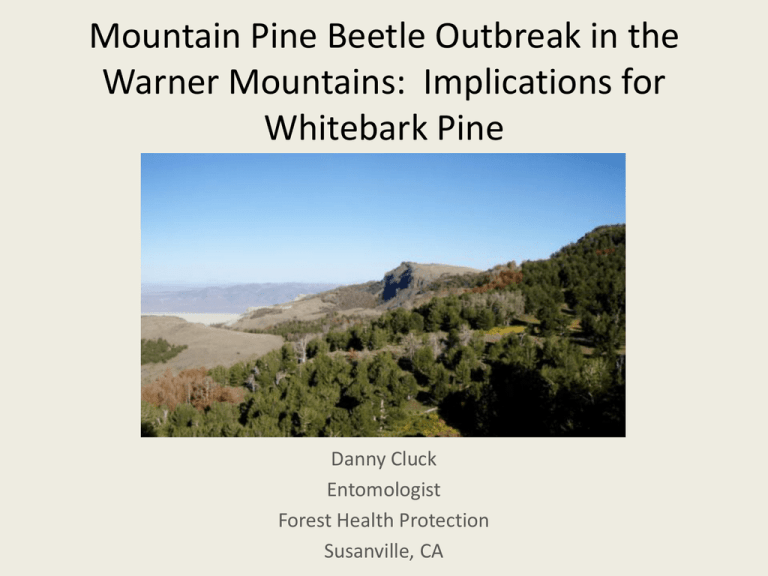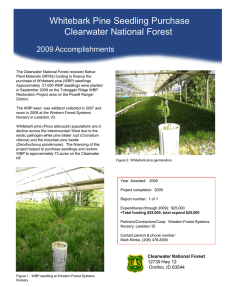Mountain Pine Beetle Outbreak in the Warner Mountains: Implications for
advertisement

Mountain Pine Beetle Outbreak in the Warner Mountains: Implications for Whitebark Pine Danny Cluck Entomologist Forest Health Protection Susanville, CA Mountain Pine Beetle Outbreak in the Warner Mountains Why here, why now? Climate Change • The Warner Mountain region has not exhibited a significant change in mean or minimum temperatures in the last 80 years based on local weather station data and the PRISM climate model shows some Warner Mountain areas are cooler • The northeastern California climate zone has exhibited a general increase in annual precipitation by an average of 3 inches since 1931 Merriam and Safford 2011 Do cold winter temps control mountain pine beetle populations in California? • -30°F must be sustained for at least five days for a large number of MPB larvae to be killed during the middle of winter • The ability of MPB to acclimate to colder temperatures is likely sufficient to prevent a significant winter mortality event in California as temperatures in forested areas rarely if ever drop to lethal levels for an extended time (Yuill 1941) • Cold-induced caused MPB mortality may not play as big a role in California as in northern latitudes (Bentz 2013) Does a warmer climate result in more mountain pine beetle generations per year? In this warm environment (Southern California), MPB is living at or very close to it’s optimal temperature. Small increases can have negative impacts on fitness. The thermal “safety margin” is small. Hotter is not always better Evolved adaptations reduce MPB capacity to take full advantage of increased thermal heat at warmest sites, limiting potential for bivoltinism (two generations/year) within current realized distribution At higher latitudes and elevations, populations are currently living at environmental temperatures cooler than their optimal temperatures, such that climate warming may enhance fitness 2013 California Forest Pest Council presentation: Phenology and Life History Characteristics of Mountain Pine Beetle and Jeffrey Pine Beetle - Barbara J. Bentz, RMRS Mountain Pine Beetle in the Warner Mountains • Generally one generation per year (some may need two years to complete development) • Attacks from July through September Short-term changes in temperature Average Temperature - June/July/August California Division 3 (Great Basin) 65 64 Degrees Farenheit 63 62 61 60 59 58 57 56 1987 1989 1991 1993 1995 1997 1999 2001 Year 2003 2005 2007 2009 2011 2013 Average Annual Temperature (F) Year 2010 2007 2004 2001 1998 1995 1992 1989 1986 1983 1980 1977 1974 1971 1968 1965 1962 1959 1956 1953 1950 1947 1944 1941 1938 1935 1932 1929 1926 1923 1920 1917 1914 1911 1908 1905 Temperature (F) Average Annual Temperature 1905 - 2012 (Oct - Sept), California Division 3 (Great Basin) 49 48 47 46 45 44 43 42 41 • Whitebark pine is more widespread and occurs in denser stands than it did 150 years ago (Figura 2006 and Vale 1977). • Episodic recruitment at low elevations and continuous at higher elevations Figura 2006 Whitebark pine diameter distribution Based on 18 FHP plots – est. 2010 800 700 600 TPA 500 400 300 200 100 0 <1.0 1.0 - 4.0 4.1 - 8.0 8.1 - 12.0 12.1 - 16.0 16.1 - 20.0 20.1 - 24.0 24.1 - 28.0 28.1 - 32.0 32.1 - 34.0 34.1 - 38.0 DBH (in) Precipitation and Drought Palmer Hydrologic Drought Index (PHDI) 1896 - 2013 Water Year (Oct-Sept), California Division 3 (Great Basin) 4 2.83 Palmer Hydrologic Drought Index 3 2.81 1.77 2 1 0.57 0 -1 -0.84 -0.94 -1.02 -1.3 -1.61 -2 -1.92 -3 -2.57 -2.75 -3.14 -3.42 -4 2000 2001 2002 2003 2004 2005 2006 2007 Year 2008 2009 2010 2011 2012 2013 Mountain Pine Beetle Outbreak 2005 - present Forest Health Protection Aerial Detection Survey 2006 - 2007 Forest Health Protection Aerial Detection Survey 2006 - 2009 Forest Health Protection Aerial Detection Survey 2006 - 2011 Forest Health Protection Aerial Detection Survey 2006 - 2013 Forest Health Protection Aerial Detection Survey 2006 - 2007 Forest Health Protection Aerial Detection Survey 2006 - 2009 Forest Health Protection Aerial Detection Survey 2006 - 2011 Forest Health Protection Aerial Detection Survey 2006 - 2013 Mt. Bidwell 2007 Mt. Bidwell 2011 Mountain pine beetle impacts to cone production 100.0% 3.8% 5.5% 16.7% 90.0% 23.4% 80.0% 4.6% 70.0% 10.0% Dead >5 years 60.0% MPB killed <5 years 50.0% 92.7% 40.0% Green Infested 77.0% Green Trees 62.8% 30.0% 20.0% 10.0% 0.0% < 4.0" dbh (2.2% producing cones) 2013 - 12% mortality 4.0 - 8.0" dbh (43.4% producing cones) > 8.0" dbh (84.1% producing cones) 27% mortality 34% mortality Plot # 1 2 3 4 5 6 7 8 9 10 11 12 13 14 15 16 17 18 % of BA Age of dominant/ Stems/Hectare suitable host codominant 94 99 93 93 90 97 85 95 93 94 91 98 97 97 97 88 97 96 >80 >80 <60 >80 >80 >80 >80 >80 >80 >80 >80 >80 >80 >80 >80 >80 >80 >80 780 1899 1159 1139 1799 1199 1259 1079 880 520 880 720 920 760 1100 2139 1259 820 Susceptibility Rating Observed % mortality 94 79 9 93 72 97 85 95 93 47 91 49 97 97 97 44 97 96 34 67 0 82 0 0 14 6 0 13 0 20 0 0 15 75 53 57 Future of whitebark pine in the Warner Mountains? • Most larger diameter LPP and WBP stands that helped facilitate the current outbreak are or will likely be decimated • Most large diameter LPP and WBP will likely be thinned from mixed size class stands • There may be an extended period of reduced cone production and Clark’s nutcracker facilitated reforestation Future of whitebark pine in the Warner Mountains? • Large areas of small diameter whitebark pine should have high levels of survival • WBP regeneration exists in nearly all MPB killed stands and should survive (and thrive?) • It does not appear that white pine blister rust will significantly impact whitebark pine regeneration in the near future White pine blister rust • • • • WPBR confirmed or suspected on 9 plots Confirmed infection on 0.6% of WBP stems Confirmed/suspected on 1.7% of WBP stems No mortality attributed to WPBR infections Pityogenes spp. and Pityophthorus spp. Found attacking: • small diameter WBP within clumps where MPB is killing larger stems • limbs and tops of MPB attacked WBP and LPP (even large diameter LPP) • Individual small diameter WBP growing at lower elevations on poorer sites. Pityogenes spp. and Pityophthorus spp. Pityophthorus spp. • Uncommon in plots and most of Warner Mountains • Heavy infestation reported in 2009 on over 150 acres of whitebark pine at north end of wilderness • Elevated levels on west slope of Eagle Peak in 2012 Shoot Moth (Possibly Rhyacionia sp.) • Twigs tend to break off at point of attack • Might be reducing cone production on individual trees Limber Pine Dwarf Mistletoe (Arceuthobium cyanocarpum) •Uncommon; only observed in one small area in south Warners Thank you! Acknowlegments: Rachel Simons, Botanist/Forester, Modoc NF Judy Perkins, Botanist, Modoc NF Krystina Smith, Forester, Modoc NF Amanda Grady, Entomologist, FHP Rueben Mahnke, Biological Technician, FHP Meghan Woods, GIS Analyst, FHP Cynthia Snyder, Entomologist, FHP




